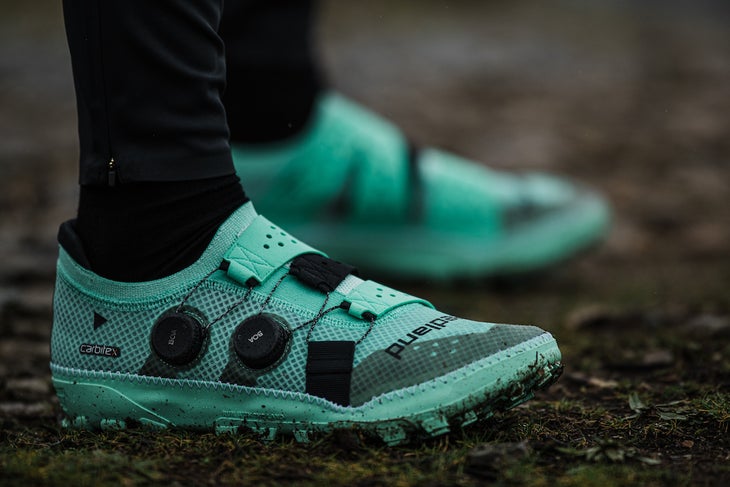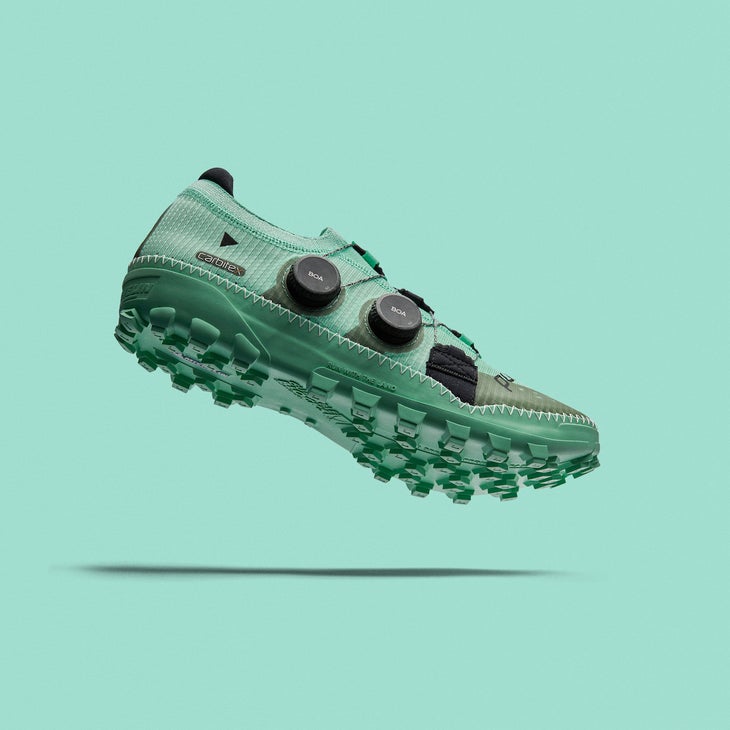New perk! Get after it with local recommendations just for you. Discover nearby events, routes out your door, and hidden gems when you sign up for the Local Running Drop.
Dave Dombrow and Kevin Fallon are two of the most imaginative minds in the running shoe business.
You’ve probably never heard their names or seen their faces, but the industry veterans have probably had a hand in designing some of the Nike, Puma or Under Armour shoes you’ve seen or worn over the past two decades. If you have seen them, though, it’s probably because you’ve watched their enterprising SpeedHack web series on YouTube, a mashup show in which they have fun deconstructing running shoes to build a variety of newfangled footwear.
The self-professed running shoe geeks have taken Nike Alphafly Next% marathon racing shoes and converted them into a mountain bike shoes. They’ve turned Adidas soccer cleats into trail running shoes. They’ve even taken running shoes from two eclectic start-up brands — Atreyu’s no-frills $75 shoes and $825 Courser’s hyper-luxe shoes — and created what might be the world’s first true high-fashion, high-performance model.

But it turns out the SpeedHack show, as entertaining and smartly done as it has been, has really just been a temporary ruse for something bigger. Dombrow and Fallon have just launched Speedland, an innovative new brand of premium trail running shoes with some rather unique features. Their first model, the SL:PDX, will be in August with a lofty $375 price tag. Yes, that’s right, $375.
RELATED: The Best Trail Running Shoes We’ve Tried
The SL:PDX, which is named in honor of the trails near their Portland, Ore., design lab, has a removable Carbitex carbon-fiber plate with an asymmetrical flex that’s stiff in one direction, but flexible in the other, offering what Dombrow says is “the perfect balance of responsiveness and energy return.” The shoe features two BOA Li2 dial closures connected to support straps integrated to a Dyneema knit upper and a removable Pebax foam midsole. Perhaps most interesting, the SL:PDX also features a Michelin rubber outsole with lugs that can be — and are meant to be — permanently trimmed to match the regional terrain.
Fallon said he and Dombrow wanted to start with a blank canvas and remove any preconceived limitations tied to “commodity products” that are developed to a price point and distributed through traditional retail channels. Instead, they wanted to create premium “equipment” for high-end trail running performance without cutting any corners.
“We just wanted to take off all of those shackles and say, ‘Let’s focus on the athlete,’” Fallon says. “And what we’re seeing in trail running today are athletes who are really pushing the edge of human performance. Where the marathon used to represent the pinnacle in running, now we’re seeing that in 100K and 100-mile events and beyond. Commodity footwear doesn’t belong in that category. What belongs in that category is high-performance equipment that they can rely on in a way that they haven’t had an opportunity in the past.”
RELATED: What You Need To Know About Running Shoes And Injuries
The brand will have a small-batch manufacturing approach — only 1,200 pairs in the first production run — and will conitnnue with sporadic one-off shoe releases tied to the types of trail conditions in various regions of the U.S. It’s a concept that Dombrow likens to how specific tires are selected for different Formula One tracks and other gear that is specifically tuned to the conditions and terrain of a competition venue.
The SL:PDX is designed for the often muddy and sloppy trails of the Pacific Northwest, although the lug-shearing concept and removable parts allow it to be adaptable to other regions.
Colorado-based elite ultrarunner Don Reichelt, one of the brand’s first athlete ambassadors, wore a pair en route to winning the Salt Flats Endurance Run 50K at the Bonneville Salt Flats, Utah. Other athletes on their roster include Liz Canty, Dean Karnazes, Liam Lonsdale and Caroline Austin. The brand plans to give back 10% of its profits to outdoor programs its athletes choose.
“It’s been so cool working with these guys because they’re brilliant and they’re obsessed with doing something different and getting it right,” Reichelt says. “They’re not out there trying to sell a big box shoe that’s sold at Dick’s Sporting Goods or Famous Footwear. This isn’t a shoe, this is a piece of equipment, and it’s definitely changing the perspective. It’s not for everybody and they’re cool about that. This is different.”
Speedland is meant to be unlike anything else available on the market, Dombrow says. As such, its products will not be sold at running shops or on retail stores and only direct through its own site.

The trail running shoe sales have growing on a global basis for 20 years. With trail running participation expected to boom now that the Covid-19 pandemic is subsiding, market analysts expect the footwear category to grow nearly 6 percent per year through 2025.
As the sport continues to grow, Speedland products will provide niche solutions that haven’t been considered before with mass-produced shoes, Dombrow says.
“Think about hyper-performance, so it’s as high-performance as it can be, which then takes you into the category of equipment, rather than shoes,” Dombrow says. “When you do that, you start to look at comparable gear in other sports and put it into the context of skis and ski boots or mountain bikes and other things in that frame of mind. On a very macro level, if you can just build the best of the best of the best and not compromise on any term, that’s what Speedland is all about. And there’s nothing else in the trail running world that’s built with that no-compromise approach.”
The most exotic feature? The $375 price tag! Orders are being taken online with a promise of an August delivery. Want to learn more about Speedland? Watch this teaser video.
Dombrow and Fallon met while working as basketball shoe designers at Nike in 2000. They later each worked at Puma, with Kevin in the company’s German office and Dave in Boston, and then both wound up at Under Armour when the brand was just getting into running.
“Nike Basketball was a pretty interesting place to learn a whole bunch of stuff about shoe design and about the industry in general.”
“Leaving Under Armour for a variety of reasons, we both just felt like, ‘this is our chance to do something, and everything we’ve done to this point is leading to something different. And if we don’t take that chance now, we might not do it, so we decided to do this new venture.
